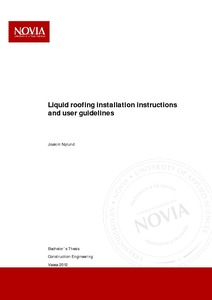Liquid roofing installation instuctions and user guidelines
Nylund, Joakim (2012)
Nylund, Joakim
Yrkeshögskolan Novia
2012
All rights reserved
Julkaisun pysyvä osoite on
https://urn.fi/URN:NBN:fi:amk-201301161461
https://urn.fi/URN:NBN:fi:amk-201301161461
Tiivistelmä
Målet med detta ingenjörsarbete var att utarbeta en manual kallad, ”Liquid roofing installations instruktioner och applikationsanvisningar”. Syftet med denna manual är att skapa en större förståelse för denna typ av produkter i allmänhet. Denna manual kommer också att tillhandahålla läsaren med installationsinstruktion samt vägledning i hur liquid roof systemet appliceras på företagets specifika taktyper. Vidare kommer att jämföras olika tillverkares liknande produkter, med tanke på förvaringstider, appliceringstemperaturer, garantier och arbetsmetoder. I arbetet kommer även att övervägas användandet av liquid roof -systemet i kraftverksprojekt överlag, med tanke på ovannämnda faktorer samt de garantier de olika tillverkarna kan ge The objective of this thesis has been to develop a manual called “Liquid roofing installation instructions and user guidelines”.
The purpose of this manual is to create a better knowledge of liquid roofing systems in general. The manual also provides the reader with installation instructions and guidelines for how to apply liquid roofing systems onto company specific roof types.
Furthermore the manual compares different manufacturers´ products, to see their benefits and drawbacks regarding storage life, application temperatures, warranties and ways of working during application.
I have also considered the use of the liquid roofing systems in power plant projects in generally, paying attention to the factors mentioned as well as the warranty periods that the manufacturers can provide.
The purpose of this manual is to create a better knowledge of liquid roofing systems in general. The manual also provides the reader with installation instructions and guidelines for how to apply liquid roofing systems onto company specific roof types.
Furthermore the manual compares different manufacturers´ products, to see their benefits and drawbacks regarding storage life, application temperatures, warranties and ways of working during application.
I have also considered the use of the liquid roofing systems in power plant projects in generally, paying attention to the factors mentioned as well as the warranty periods that the manufacturers can provide.
